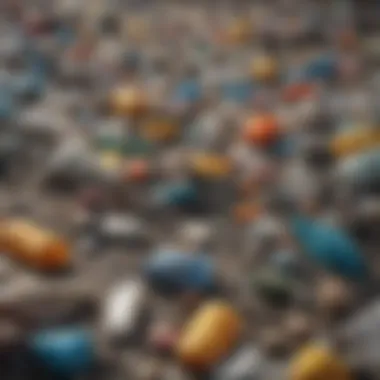Plastic Pollution: Causes, Impacts, and Solutions


Intro
Plastic pollution remains one of the urgent environmental challenges facing our planet. In 2020, the situation regarding plastic waste reached critical levels, leading to significant impacts on both marine and terrestrial ecosystems. This article aims to delve into the state of plastic pollution during this year, examining the origins, consequences, and societal responses aimed at alleviating this pressing problem.
Understanding the scope of plastic pollution requires an analysis of various studies and reports from 2020, which highlighted not only the growing prevalence of plastic waste but also its multifaceted nature. It is impossible to ignore the stark evidence collected by researchers and organizations, outlining the overwhelming presence of plastics in our oceans, rivers, and even within the food chain.
Research Overview
Key Findings
The research conducted in 2020 revealed alarming statistics about plastic waste:
- Approximately 300 million tons of plastic were produced globally, with a significant portion entering natural habitats.
- Over 1 million marine creatures and countless terrestrial animals are impacted by plastic ingestion and entanglement.
- Plastics take centuries to decompose, leading to long-term environmental consequences that threaten biodiversity.
"The scale of plastic waste has exceeded our capacity to manage it effectively, showcasing deep-rooted systemic failures in waste management practices."
Study Methodology
Research methodologies varied across different studies but generally included:
- Data collection from various environmental organizations.
- Field observations and marine ecosystem studies.
- Surveys of consumer behavior regarding plastic use and recycling efforts.
Such comprehensive methodologies offer a holistic view of the plastic pollution crisis, reinforcing the urgent need for effective interventions.
Background and Context
Historical Background
Plastic use began in the early 20th century, when it was celebrated for its versatility and affordability. However, as its production increased, so did its environmental ramifications. Initial awareness of plastic pollution emerged in the late 1970s, but it took decades for legislative and public responses to catch up.
Current Trends in the Field
The trend in 2020 leaned increasingly towards addressing plastic pollution through various initiatives:
- Governments and international organizations proposed stricter regulations on single-use plastics.
- Public campaigns sought to enhance awareness and encourage sustainable lifestyle choices.
- Innovations in materials science aimed at developing biodegradable alternatives to traditional plastics.
These trends highlight an evolving understanding among stakeholders about the need for both immediate and long-term responses to the issue of plastic pollution.
Prelude to Plastic Pollution
Plastic pollution has emerged as a critical issue in recent decades, shaping both environmental discourse and policy initiatives. This section aims to outline the various dimensions of plastic pollution, making it clear how it permeates multiple facets of society and nature. Understanding plastic pollution is essential, as it highlights the urgency required in tackling this problem, fostering informed decision-making among communities, businesses, and governments.
Definition of Plastic Pollution
Plastic pollution refers to the accumulation of plastic products in the environment, adversely affecting ecosystems and wildlife. It encompasses various forms of plastics, ranging from single-use items such as bags and bottles to microplastics that are less than five millimeters in size. These materials often do not biodegrade or break down easily, leading to long-term environmental consequences. This term also extends to the processes that contribute to the inadvertent release of plastic waste into natural habitats.
In 2020, the rising tide of plastic pollution became evident. With heightened consumerism and inadequate waste management systems, plastics reached various ecosystems, demonstrating a pervasive threat. According to recent data, over 300 million tons of plastic are produced annually, and a significant portion ends up in oceans, rivers, and even the air we breathe.
Historical Context
The origins of plastic pollution date back to the early 20th century with the advent of synthetic plastics. Originally praised for their versatility and resilience, plastics quickly became integral in many sectors. However, their durability, once considered an advantage, now poses a significant risk to the environment. The mass production of plastics accelerated in the post-World War II era, resulting in unprecedented levels of consumption.
Throughout the decades, awareness regarding the impact of plastic waste has grown. In the 1970s, the first environmental campaigns targeting plastic waste emerged, drawing public attention to its consequences. However, despite ongoing awareness, plastic production and waste generation continued to rise, often outpacing efforts aimed at mitigation. By the turn of the 21st century, the issue had escalated to a global challenge, compelling researchers, policymakers, and activists alike to advocate for change.
Today, the discussion surrounding plastic pollution encompasses multiple aspects. From the effects on marine life and terrestrial ecosystems to human health implications and economic consequences, it is clear that plastic pollution is not a niche concern but a universal challenge that requires holistic solutions. Understanding these historical contexts provides a framework for examining the structures and behaviors that perpetuate plastic pollution, ultimately informing future strategies to combat this pressing issue.
Sources of Plastic Waste in
Understanding the sources of plastic waste in 2020 is essential for grasping the wider implications of this environmental issue. The origins of plastic waste are multifaceted, intertwining with human behavior, industrial practices, and global trade dynamics. By dissecting these elements, we can identify patterns, assess their impacts, and propose actionable solutions to mitigate plastic pollution.
Consumer Behavior and Packaging


Consumer behavior significantly influences the amount of plastic waste generated. Everyday choices, from the products we buy to how we dispose of them, create a ripple effect in the environment. In 2020, single-use plastics continued to dominate packaging, primarily due to convenience and affordability. Items like plastic bags, straws, and food packaging are prevalent in households and can often end up discarded after a single use.
The rise of e-commerce contributed to increased packaging waste, as online retailers prioritized product protection. In many cases, excessive packaging has become the norm, rather than the exception. Consumers showed a fluctuating trend towards sustainable choices, spurred by growing awareness, yet the convenience of plastic packaging often overshadowed eco-friendly alternatives.
In addition, the COVID-19 pandemic reshaped many consumer habits. Increased delivery services and take-out meals further amplified the demand for plastic. Consequently, understanding consumer dynamics became crucial in tackling plastic pollution by promoting responsible buying habits and raising awareness about alternatives.
Industrial Contributions to Plastic Pollution
Industries play a significant part in the plastic waste problem, with manufacturing processes and product designs being key contributors. In 2020, sectors like packaging, automotive, and consumer goods generated substantial amounts of plastic waste. The essence of many products is often plastic due to its versatility, durability, and low cost. However, these attributes also mean that plastics can persist in the environment for centuries without breaking down.
The focus of industries is frequently on profit margins and production efficiency rather than sustainability. As a result, there is still a lack of robust practices to minimize plastic waste at the source. While some companies have initiated programs to reduce plastic use and implement recycling, many still prioritize plastic in their supply chains.
Furthermore, corporate responsibility in waste management varies greatly. Companies that do not invest in sustainable practices contribute to the problem, impacting the environment adversely. Addressing industrial contributions to plastic pollution requires collaborative efforts to innovate product designs and improve waste management practices.
Global Trade and Plastic Waste Exportation
The global trade in plastic waste has become a significant issue, complicating the management and disposal of plastic materials. In 2020, many countries exported plastic waste for recycling, often to less developed nations, which poses a risk for inadequate management and environmental harm.
Countries that import plastic waste face challenges like insufficient infrastructure for recycling and proper waste handling. As a result, much of the plastic waste is either improperly disposed of or ends up in landfills and oceans, exacerbating the pollution crisis. Major global players in the plastic trade, including the United States and European Union, grappled with the implications of their waste export practices.
In summary, the sources of plastic waste in 2020 arise from a combination of consumer habits, industrial practices, and international trade practices. Addressing these sources holistically is essential in crafting effective solutions and policies to combat plastic pollution.
Environmental Impacts of Plastic Pollution
The environmental impacts of plastic pollution are profound and multifaceted, affecting various ecosystems and ultimately human health. Understanding these impacts is crucial as they encompass not just the immediate effects on wildlife and habitats, but also long-term consequences for biodiversity and ecological balance. Recognizing the significance of these issues allows for informed discussion and action towards sustainable practices.
Effects on Marine Life
Marine life is one of the most directly affected by plastic pollution. Plastics can be found in oceans, rivers, and lakes, causing harm to marine organisms. Ingestion is a significant concern. Marine animals, such as turtles and seabirds, often mistake plastic debris for food. Consuming these materials can lead to malnutrition, internal injuries, and even death.
Plastic waste also leads to entanglement. Species such as seals and large fish can become trapped in discarded nets and ropes, inhibiting their ability to swim, hunt, or reproduce. According to research, about 100,000 marine mammals die each year due to plastic pollution. These alarming figures signify a harsh reality for marine ecosystems and highlight the urgency for intervention.
"The growing presence of microplastics in the oceans poses alarming threats. These tiny particles can be ingested by small marine creatures, entering the food chain and ultimately affecting human health."
Impact on Terrestrial Ecosystems
On land, plastic pollution disrupts terrestrial ecosystems in multiple ways. Plastic debris can litter landscapes, affecting visual aesthetics and quality of life. It can also interfere with animal habitats. Animals may encounter plastic waste while foraging, leading to similar ingestion issues witnessed in marine environments. The soil can become contaminated when plastics break down into smaller particles, affecting plant growth and soil health. This contamination can have a cascading effect on the entire food web.
Moreover, wildlife is at risk as plastics can leach harmful chemicals into the environment. These chemicals can disrupt hormonal systems in animals, potentially leading to reproductive issues in species such as amphibians and birds. Another consequence is the buildup of plastics in freshwater systems, which can influence water quality and availability.
Human Health Risks Associated with Plastics
The implications of plastic pollution extend to human health, particularly through the consumption of contaminated food and water. Microplastics have been found in various food sources, including seafood and even drinking water. Consuming these contaminants can pose serious health risks, including hormonal disruptions and increased exposure to toxic substances leached from plastics.
Additionally, the burning of plastic waste can release harmful pollutants into the air. These pollutants can lead to respiratory issues and other health problems within communities near waste disposal sites. The health ramifications are concerning and deepen the urgency for immediate action on plastic pollution.
In summary, the environmental impacts of plastic pollution encompass a broad range of effects across marine and terrestrial ecosystems, coupled with significant risks to human health. Addressing these impacts requires a commitment to reducing plastic usage, enhancing waste management practices, and promoting public education on the dangers of plastic pollution.
Economic Consequences of Plastic Pollution
Understanding the economic consequences of plastic pollution is vital for comprehending its broad effects on society and the environment. This segment focuses on two critical areas: the cost of clean-up operations and the impact on key industries such as fisheries and tourism. Each of these elements plays a significant role in shaping local economies and raises awareness about the urgent need for effective solutions.
Cost of Clean-up Operations
The cost of cleaning plastic waste from natural environments continues to escalate. In many coastal areas, governments allocate substantial resources for beach clean-ups and waste management. According to various studies, cities spend millions annually to remove plastics from shorelines and urban areas.
Labor and equipment for these operations add to the financial burden. The reliance on taxpayer funds often strains local budgets. To illustrate:
- Cities like San Francisco and Jakarta have reported annual expenses ranging from $30 million to $50 million for debris removal alone.
- Countries with extensive coastlines, such as the Philippines, face even higher expenses due to recurring waste accumulation.
Moreover, clean-up operations do not always address the root causes of pollution. Without effective regulations on plastic consumption and disposal, the cycle of pollution persists. The economic implications extend beyond direct financial costs; they affect public health and community well-being.


Impact on Fisheries and Tourism Industries
Plastic pollution has dire consequences for both the fisheries and tourism sectors. The fishing industry suffers from declining fish populations due to microplastics contaminating aquatic environments. Fishermen face reduced catches, which translates into lesser income. This dynamic not only impoverishes fishermen but also threatens food security in regions reliant on seafood.
- Reports suggest that fisheries revenues have dropped as much as 30% in heavily polluted waters.
In parallel, the tourism industry also incurs substantial losses. Coastal regions often attract tourists for their beauty and biodiversity. Plastic-littered beaches and polluted marine areas deter visitors, leading to a decrease in tourism revenue. Key data highlights include:
- Some tourist hotspots have experienced a 20% decline in visitor numbers due to environmental conditions.
- This drop affects local businesses dependent on tourism, triggering a broader economic downturn.
The repercussions illustrate the interconnectedness of environmental health and economic viability. Sustainable practices can mitigate these impacts, but they require collaborative efforts among stakeholders to foster solutions.
"The costs of plastic pollution touch every corner of our economy, highlighting the urgent need for reform."
In summary, the economic consequences of plastic pollution reach far beyond immediate financial concerns. They encompass threats to livelihoods, the sustainability of industries, and the overall health of communities. Moving forward, understanding these dimensions is crucial to developing effective policy measures and promoting a cleaner environment.
Legislative Responses to Plastic Pollution
Legislative measures play a critical role in addressing plastic pollution. They establish frameworks that guide reduction, recycling, and responsible disposal of plastic waste. Effective legislation can lead to meaningful change in consumer behavior, industry standards, and global cooperation. By setting regulations, governments can incentivize sustainability and restrict harmful practices associated with plastic production and disposal.
Policies regarding plastic pollution often target key areas including production limitations, waste management improvements, and recycling initiatives. Here are a few important considerations of these responses:
- Encouragement of Circular Economy: Legislation can foster a circular economy by promoting the reuse and recycling of plastics. This shift not only minimizes waste but also conserves resources.
- Regulation of Single-use Plastics: Many countries have implemented ordinances that ban or limit single-use plastic products, encouraging consumers to adopt more sustainable alternatives.
- Funding for Research and Development: Governments can allocate funds towards developing better waste management technologies and biodegradable plastic alternatives.
Understanding and analyzing these legislative responses provide insight into the strategies being employed globally to combat plastic pollution.
National Policies and Regulations
National policies vary across countries, but many share common themes. In 2020, several nations passed legislation aimed at reducing plastic pollution. For instance, the European Union has been prominent in establishing policies that promote greener practices. Key regulations include:
- Directive on Single-use Plastics: This EU directive prohibits certain single-use plastic items such as straws, stirrers, and cotton buds, pushing member states to reduce plastic consumption.
- Extended Producer Responsibility (EPR): Some nations enforce EPR policies, where producers are held accountable for the entire lifecycle of their products, including disposal and recycling.
These policies often involve cooperation with industries to create viable alternatives that reduce reliance on plastic products. The emphasis is on striking a balance between economic growth and environmental stewardship.
International Agreements and Cooperation
Despite national efforts, plastic pollution is a global issue that cannot be solved in isolation. International cooperation is essential. Several agreements have emerged to forge a unified front against plastic waste:
- The Basel Convention: This treaty regulates the transboundary movement of hazardous waste. In 2020, it was amended to include plastic waste, ensuring that countries must abide by stringent rules when importing or exporting plastics.
- Global Partnerships: Initiatives like the Global Plastic Action Partnership bring together governments, businesses, and civil society to share best practices and develop strategies for reducing plastic waste.
These international agreements underscore the necessity of global collaboration. They facilitate the sharing of technologies and strategies and create a collective commitment towards reducing plastic pollution.
"Addressing plastic pollution requires a multifaceted approach that integrates national legislation with global cooperation."
In summary, legislative responses, both at the national and international level, are vital in the ongoing mission to combat plastic pollution. These measures not only spur innovation but also enhance accountability among producers and consumers alike. The multifaceted nature of these responses indicates that lasting change will necessitate collaboration across all sectors of society.
Technological Innovations in Waste Management
Technological advancements play a crucial role in addressing the complexities of plastic waste. In 2020, these innovations are vital not just for improving recycling processes but also for developing alternative materials. New solutions can mitigate the impacts of plastic pollution significantly. Investment in technology can lead to better efficiency and lower environmental footprint.
Advancements in Recycling Technologies
Recycling technologies have evolved considerably in recent years. One of the significant advancements is the development of advanced sorting systems. These systems use sensors and Artificial Intelligence technology to separate plastics based on their resin type. As a result, recycling rates can increase because more plastics are correctly identified and processed.
Moreover, chemical recycling is gaining attention. Unlike traditional mechanical recycling, which limits the number of times a plastic can be recycled, chemical recycling can break down plastics into their basic monomers. This process allows for a more circular economy. Companies like Eastman are at the forefront of such technologies.
The use of blockchain technology is also emerging in recycling. It provides transparency in the recycling supply chain, ensuring that materials are processed properly. This increases accountability and could motivate more people to participate in recycling programs. The advancements highlight the synergy between innovation and environmental management.
Biodegradable Plastics: An Emerging Solution
Biodegradable plastics are becoming more popular as a response to plastic pollution. These materials aim to reduce the long-lasting presence of plastics in the environment. Unlike conventional plastics, biodegradable plastics can break down more quickly when exposed to specific conditions, such as heat and moisture.


Several types of biodegradable plastics are available, including polylactic acid (PLA) and polyhydroxyalkanoates (PHA). These materials can be used in various applications, from packaging to disposable cutlery. However, it is important to note that the conditions for biodegradation are not always met in natural environments. Hence, proper disposal methods must be established.
Educating consumers about these alternatives is essential. They need to understand the difference between biodegradable and compostable plastics. Encouraging a shift towards biodegradable options can profoundly influence the overall waste ecosystem, reducing the number of conventional plastics that contribute to pollution.
"Technological innovations are reshaping waste management, driving initiatives towards reduced plastic pollution."
Public Awareness and Community Initiatives
Public awareness and community initiatives play a critical role in addressing plastic pollution. They serve as a foundation for individual and collective actions aimed at reducing plastic waste. By fostering awareness, communities become more engaged in sustainable practices, creating a ripple effect that extends beyond local boundaries.
The first element to consider is the power of informed individuals. When communities are educated about the impacts of plastic pollution, they are more likely to change their behaviors. For instance, people may choose to reduce their use of single-use plastics, seeking alternatives that are environmentally friendly. This behavioral shift not only diminishes plastic consumption but also encourages others to partake in the movement.
Benefits of Public Awareness Initiatives:
- Enhanced Understanding: Public campaigns can clarify the consequences of plastic waste on ecosystems and human health.
- Community Empowerment: Empowered individuals feel a sense of responsibility and are more likely to lead local efforts against plastic pollution.
- Increased Participation: When awareness is raised, participation in local clean-up events and recycling programs surges, leading to cleaner environments.
Moreover, collaboration is essential. It's not only about raising awareness but also about engaging various stakeholders including schools, NGOs, and local governments. They can work together to establish programs that reach a wider audience. For instance, a partnership between local authorities and environmental groups can lead to community events focused on reducing plastic usage.
"Public engagement is crucial in mobilizing efforts against plastic pollution, as it creates informed citizens who advocate for change."
Additionally, integrating awareness into educational curricula can lay the groundwork for long-term change. When students learn about the effects of plastic pollution at an early age, they carry this knowledge into adulthood, fostering a generation that prioritizes sustainability.
Increasingly, social media platforms, such as Facebook or Reddit, have become avenues for spreading awareness. Sharing facts, engaging discussions, and success stories from grassroots movements can inspire others to take part.
In summary, public awareness and community initiatives are vital components in the battle against plastic pollution. They not only inform and empower individuals but also create a framework for collective action. Through community engagement, the impacts of plastic waste can be addressed effectively, and a more sustainable future can be envisioned.
Future Trends in Plastic Reduction
Future trends in plastic reduction play a crucial role in combating the pervasive issue of plastic pollution. Understanding these trends allows stakeholders, from policymakers to consumers, to align their efforts in a more effective manner. The focus here is on both anticipated policy developments and the rise of emerging markets dedicated to sustainable products. These elements are essential for formulating a multidimensional strategy to address plastic waste.
Policy Developments Anticipated
As awareness of plastic pollution increases, significant policy changes are expected on national and international levels. Governments are likely to establish stricter regulations regarding plastic production and consumption. These regulations could include:
- Increased taxes or levies on single-use plastics.
- Enhanced incentives for businesses that adopt sustainable practices.
- Bans on particular types of plastic that are deemed unnecessary or harmful.
- Support for research and development in biodegradable alternatives.
Such policy shifts signal a growing recognition of the need for comprehensive strategies to tackle plastic pollution. Collaborative approaches among different countries may also emerge, fostering international agreements that require member states to adhere to specific plastic reduction targets. These partnerships can amplify the overall impact, encouraging shared responsibility and resource allocation.
Emerging Markets for Sustainable Products
The demand for sustainable alternatives is carving out new markets. Consumers are increasingly opting for products that prioritize environmental responsibility. This shift is most visible in:
- Biodegradable materials: Products made from plant-based plastics or other biodegradable options are gaining traction.
- Reusable products: Items such as stainless steel water bottles and beeswax wraps are becoming popular substitutes for their single-use counterparts.
- Closed-loop products: Companies are emerging that specialize in items designed for reuse and recycling, ensuring a minimal environmental footprint.
This growing market not only benefits the planet but also encourages innovation in product design and manufacturing. As companies pivot towards sustainability, they also attract a consumer base that values corporate responsibility. Therefore, emerging markets for sustainable products are expected to expand significantly in the coming years, promoting a culture of conscientious consumption and contributing to the overall reduction of plastic waste.
"Addressing plastic pollution requires a united effort, and the trends in policies and sustainable products provide a roadmap for the future."
A comprehensive understanding of these future trends is crucial for anyone engaged in the discourse surrounding plastic pollution. Policymakers, businesses, and consumers must remain informed and active in this evolving landscape.
Culmination and Call to Action
The topic of plastic pollution is critical in contemporary discourse regarding environmental issues. This analysis of plastic pollution in 2020 reveals alarming data and trends that must be addressed urgently. Understanding the intricacies of plastic pollution is essential not only for environmental conservation but also for public health and economic stability. The connections between pollution and human activities underscore a need for proactive engagement from all sectors of society.
Summary of Findings
In 2020, plastic pollution reached unprecedented levels, primarily due to increased single-use plastics driven by consumer habits and the ongoing global pandemic. Key findings include:
- Sources: Major sources of plastic waste stem from consumer behavior, including packaging and disposable products. Industries also contribute significantly, particularly those related to manufacturing and shipping.
- Environmental Impact: Ecosystems, especially marine environments, experience dire consequences from plastic debris. Wildlife faces hazards, including ingestion and entanglement.
- Health Risks: Human health is jeopardized by microplastics and chemical leachates found in drinking water and food sources.
- Economic Fallout: Industries such as tourism and fisheries suffer economically due to the negative perceptions and realities of pollution on natural resources.
- Legislation and Innovations: National and international legislative efforts show promise, but technological innovations in waste management are still in nascent stages and require ample support.
The collective picture drawn from these findings emphasizes a comprehensive need for change. Not only does it show the scope of the issue, but it also calls for urgent measures across multiple levels.
Encouraging Responsible Practices
The responsibility to combat plastic pollution does not rest with a single entity. Consumers, manufacturers, and governments must work collaboratively towards solutions. Here are some practices that can help:
- Reduce Plastic Use: Individuals can reduce their reliance on single-use plastics by opting for reusable alternatives. Shopping with cloth bags and using glass or metal containers instead of plastic options makes a marked difference.
- Support Sustainable Brands: Purchasing from companies that prioritize eco-friendly materials and practices encourages better industry standards. Brands such as Patagonia and Ecover set examples for sustainability.
- Advocate for Policy Change: Engage with local and national representatives to support legislation aimed at reducing plastic production and increasing recycling capabilities. Demand accountability from industries to adhere to stricter regulations.
- Participate in Clean-Up Initiatives: Community involvement in beach or park clean-ups fosters awareness and engages others in sustainable practices. Building a sense of stewardship towards natural environments is crucial.
- Educate Others: Share knowledge about the impacts of plastic pollution, fostering informed discussions. Education can drive community action and encourage shifts in behavior.
As we consider the future, it becomes clear that systemic change is necessary, and every action counts. The fight against plastic pollution is a collective challenge that requires diligence and cooperation from all sectors of society. By following responsible practices, together we can make substantial strides towards a sustainable future.







